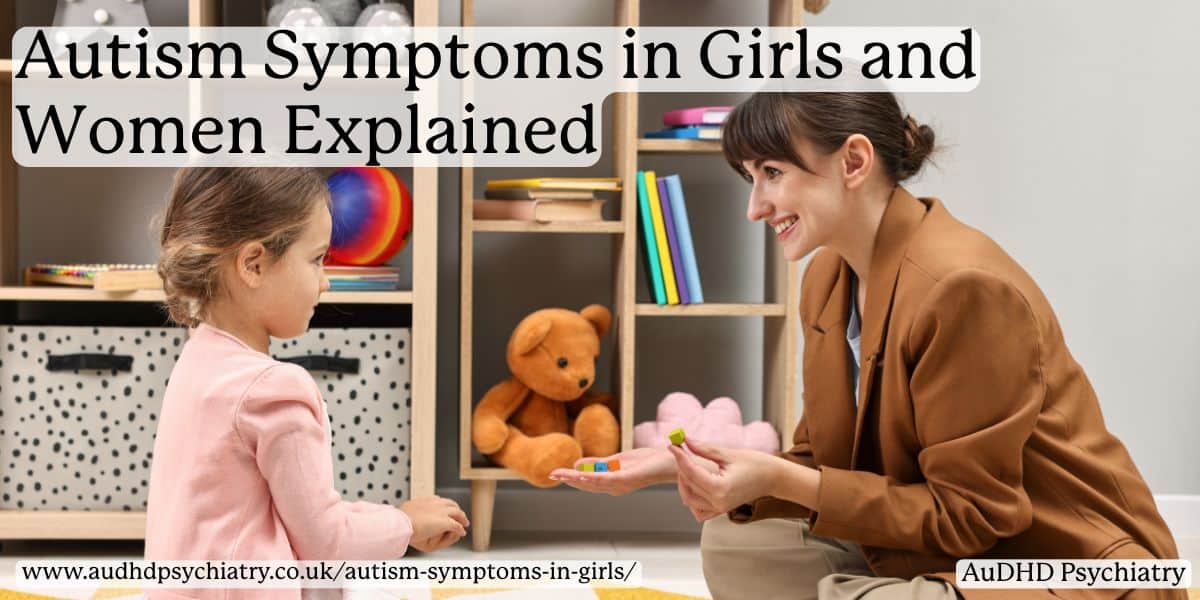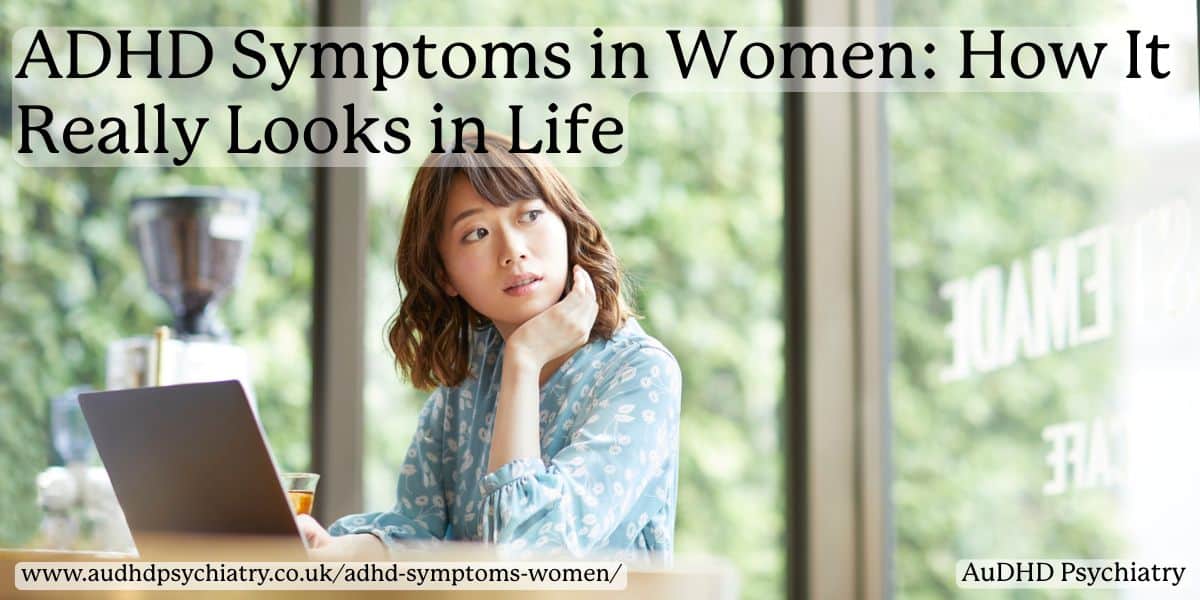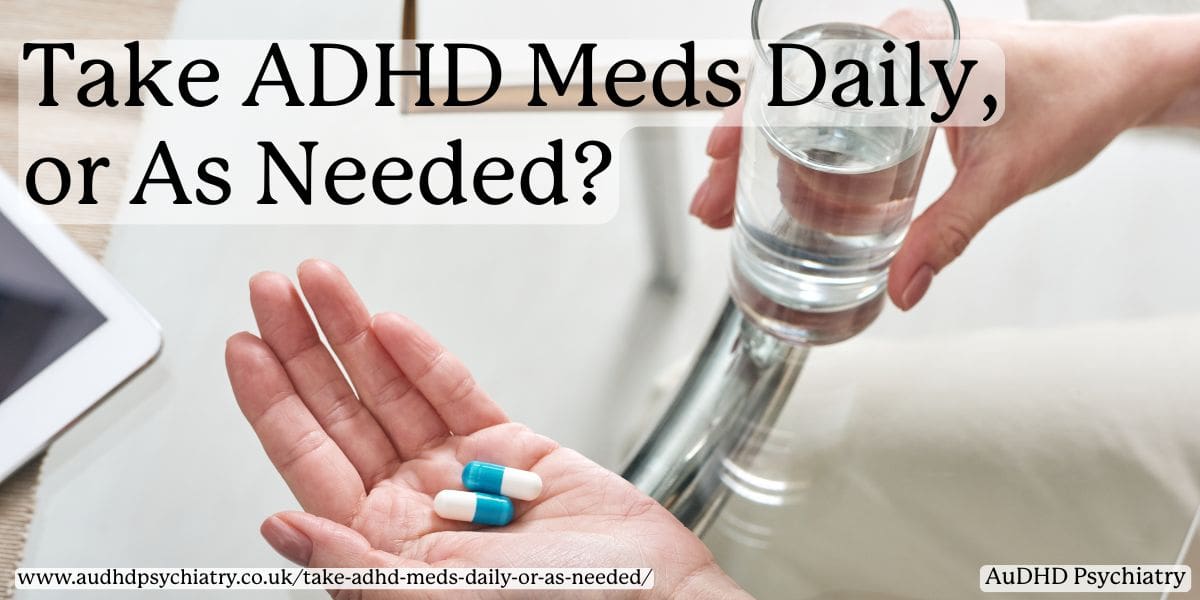
For individuals managing attention deficit hyperactivity disorder (ADHD), this question is more than a matter of convenience. It influences how treatment is experienced day to day, shaped by symptom severity, lifestyle, age, and clinical guidance.
Stimulant medications like methylphenidate and amphetamines remain central to ADHD treatment, improving focus, impulse control, and task follow-through. While some people take their ADHD meds daily, others use them only during high-demand periods, such as workdays, exams, or parenting-intensive routines.
This contrast has led to growing interest in as-needed use, also known as pro re nata (PRN), a Latin term meaning “as needed,” where ADHD medication is taken selectively rather than on a fixed daily schedule. But is this approach safe? Is it effective?
In this article, we explore whether it’s better to take ADHD meds daily or as needed. You’ll learn the pros and risks of each strategy, how factors like diagnosis subtype and life context influence your choice, and how to work with your provider to reassess and adjust your ADHD medication dosage over time.
Should You Take ADHD Medication Every Day?
For many individuals with ADHD, taking medication daily is the standard recommendation. This consistent approach helps stabilise symptoms such as inattention, impulsive behaviors, and emotional dysregulation, making daily routines, work, and relationships more manageable. It is especially common in children and young people, where structure and predictability support better long-term outcomes.
What Do ADHD Meds Do?
ADHD is a neurodevelopmental condition, and daily medication helps maintain steady levels of certain brain chemicals, such as dopamine and norepinephrine, that influence focus and behaviour. While many patients benefit from structured use of long-acting ADHD treatment, others may need periodic adjustment depending on their response. Extended-release stimulants are commonly used in daily regimens to provide all-day symptom coverage with a single medicine dose.
These long-acting medication options differ significantly from short acting ADHD stimulants like Ritalin, which may be preferable for those needing a more flexible schedule. For others, non-stimulant medications may be prescribed, particularly where anxiety or tics are also present.
When Is Daily Use Recommended?
Daily dosing is typically advised for:
- Individuals with combined-type or severe ADHD
- Children who struggle consistently at school and at home
- Adults whose symptoms interfere with multiple areas of life
- Cases where short-acting medication does not provide sufficient coverage
Daily ADHD medication use is also associated with more predictable treatment effectiveness and allows for clear tracking of benefits and possible side effects. If a person experiences emotional crashes or inconsistent focus with short-acting medication, switching to a consistent daily schedule may improve quality of life.
However, not everyone tolerates daily use well. Some individuals report persistent side effects such as reduced appetite, chest pain, difficulty sleeping, or increased anxiety. In such cases, adjustments to dose, medication type, or timing may help reduce discomfort.
Ultimately, whether ADHD medication should be taken daily depends on individual needs, goals, and response to treatment. A well-monitored plan, including periodic reviews and consideration of different medicine types created in collaboration with a healthcare provider, will ensure the best result with minimal side effects.
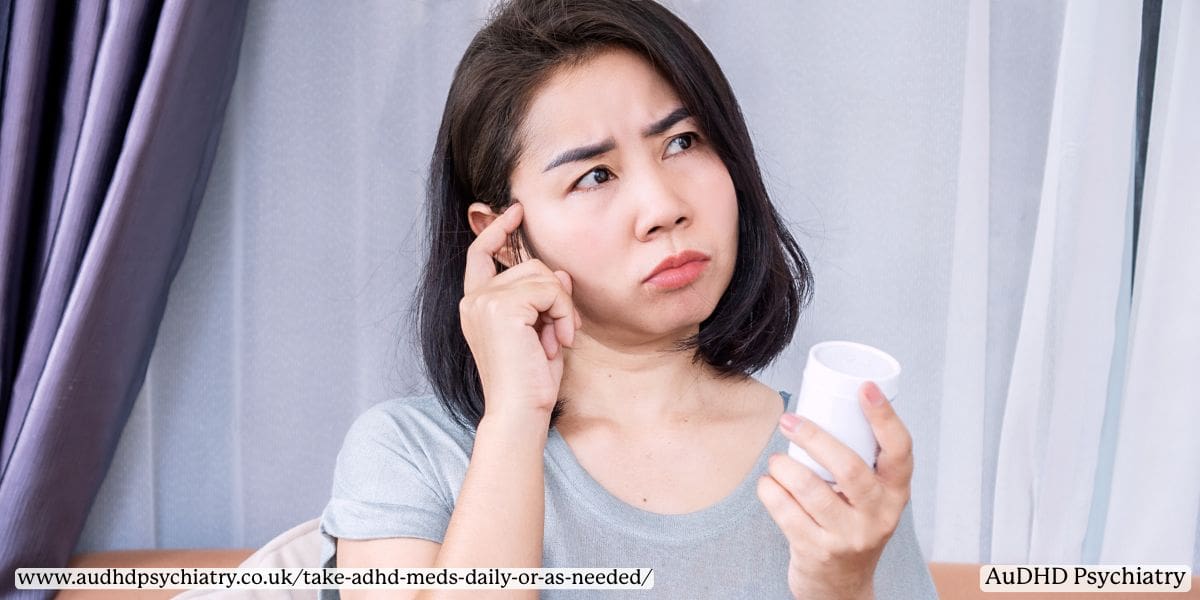
Can You Take ADHD Medication As Needed?
Not everyone with ADHD needs or wants to take medication every day. In some cases, a flexible, as-needed approach may be more appropriate. Known clinically as PRN use, this strategy involves taking ADHD medication only when symptoms are expected to interfere with specific tasks or situations.
PRN use is most often implemented with short-acting stimulants, such as immediate-release methylphenidate or dexamfetamine, which begin working quickly and wear off within a few hours. These can be used to improve focus and impulse control during study sessions, work meetings, or emotionally challenging events, while avoiding exposure to medication on low-demand days.
When Is As-Needed Use Appropriate?
As-needed use may suit:
- Adults with mild or situational symptoms
- Students who benefit from medication during lectures, revision, or exams
- Children taking weekend breaks from medication
- Individuals sensitive to side effects from daily exposure
This approach may reduce bothersome ADHD medication side effects such as sleep disturbance or appetite suppression and allow the body time to reset between doses. It can also help avoid the emotional flattening some people experience with long-term stimulant use.
Are There Side Effects to Using ADHD Meds Only As Needed?
PRN use is not without its challenges. Taking medication inconsistently may lead to rebound symptoms, such as mood swings or irritability, when the medication wears off. It can also make it harder to assess the long-term benefit of treatment, as symptoms may fluctuate too much between medicated and non-medicated days.
As-needed use should always be discussed with a healthcare professional, who can recommend appropriate medications and monitor for any unwanted effects. With the right planning, PRN use can offer meaningful symptom relief, but it is not suitable for everyone.
Daily vs As-Needed ADHD Medication: Key Differences
Choosing between daily and as-needed ADHD medication is a decision that can significantly impact treatment outcomes. Each approach has its own advantages and limitations, and what works well for one person may not be suitable for another. Understanding the clinical differences can help individuals and families make informed choices.
Daily use tends to be more stable, providing consistent support throughout the day. It’s often the best approach for managing executive function, improving academic or workplace performance, and reducing behavioural issues. In contrast, PRN use is more selective, targeting specific challenges while minimising daily medication exposure.
Comparing the Two Approaches
Here’s how daily and as-needed ADHD medication use compare at a glance. This summary can help clarify which strategy might best suit your needs or your child’s situation.
| Daily Use | As-Needed (PRN) Use |
| Consistent symptom coverage | Targeted symptom relief |
| Often better for young children | Often preferred by adults or students |
| May improve long-term outcomes | Can reduce side effects |
| Requires commitment to routine | Requires careful tracking |
Another key difference lies in the type of medication used. Extended-release medications are typically taken daily and provide a steady dose, while short-acting stimulants are more suitable for PRN use due to their fast onset and shorter duration.
Deciding which approach is right can be based on:
- ADHD severity and subtype
- Age and life stage
- Daily responsibilities and environment
- Tolerance for side effects
Remember that a collaborative, effective treatment plan created with your healthcare provider ensures that your dosing schedule aligns with your goals, lifestyle, and overall well-being.
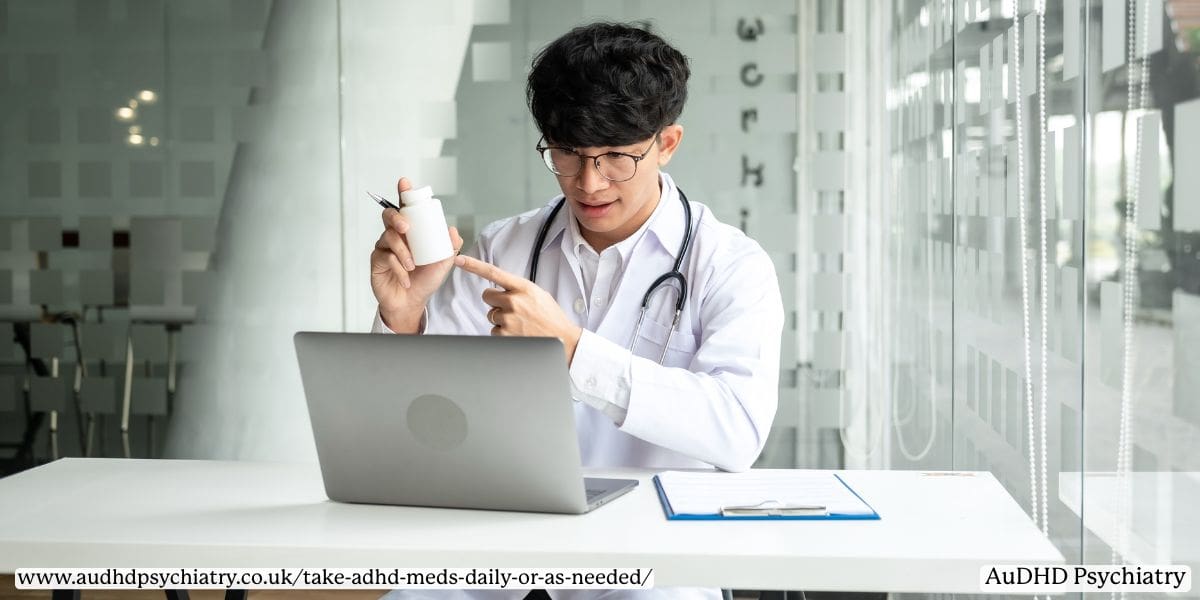
What Do Doctors Recommend for ADHD Medication Schedules?
There’s no universal rule when it comes to ADHD medication schedules. Whether medication should be taken daily or only when needed depends on various factors, including age, symptom severity, co-occurring conditions, and day-to-day responsibilities. Healthcare professionals use these variables to personalise treatment, not just the diagnosis. For individuals who may also be navigating overlapping conditions, an autism assessment for adults can provide additional insights that shape treatment decisions.
When Daily Use Is Typically Recommended
Doctors tend to recommend daily medication for:
- Children and adolescents
- Individuals with combined-type ADHD
- People whose symptoms affect them in multiple settings (e.g. school, work, home)
Daily use allows for stable levels of certain brain chemicals, such as dopamine and norepinephrine, which regulate focus and behavioural control. It also ensures consistent management of ADHD symptoms, which is particularly important in structured environments like classrooms or the workplace.
When As-Needed Use Might Be Approved
As-needed (PRN) use is more common in adult ADHD. It may be appropriate when:
- Symptoms are milder or task-specific
- The person is highly self-aware and structured
- Short-acting medication provides sufficient relief
Still, even flexible medication use should follow a medically reviewed plan. Without guidance, people risk inconsistent outcomes or mismanaging side effects. That’s especially important during times of external disruption, such as when supply issues arise. If you’re dealing with prescription delays, see our guide on how to handle ADHD medication shortages for strategies and alternatives.
Ultimately, the decision should be made jointly between you and your healthcare provider, with regular reviews to assess progress and make safe, informed adjustments.
What Are the Risks of Taking ADHD Meds Only Occasionally?
While taking ADHD medication only as needed may seem appealing, especially for those trying to manage side effects, this approach carries specific risks. PRN use can lead to unpredictable symptom control, and in some cases, it may reduce the overall effectiveness of treatment.
Rebound Symptoms and Emotional Instability
One major concern with as-needed use is the rebound effect. As medication wears off, especially short-acting stimulants, individuals may experience increased irritability, fatigue, or restlessness. These symptoms can feel worse than baseline ADHD and can interfere with relationships or emotional regulation.
Inconsistent use can also cause a mismatch between expectations and performance. Someone might perform well on medicated days and struggle significantly on non-medicated ones, creating frustration or self-doubt.
Sleep Disruption and Appetite Changes
Even when used occasionally, stimulants can affect appetite and sleep. Taking them late in the day, or sporadically, may confuse the body’s natural rhythms and lead to poor sleep quality. These physical side effects may be harder to manage when medication use is irregular.
If you’re concerned about the long-term sustainability of your current approach or suspect your strategy may be causing more harm than good, you might want to explore alternatives to ADHD medication. These may complement your treatment or, in some cases, reduce the need for medication altogether.
PRN use should always be approached with medical supervision. For many people, consistency yields better symptom control and fewer emotional or physical side effects over time. In some cases, inconsistent dosing may also contribute to medication rebound, particularly in individuals transitioning to a new ADHD medicine or formulation.
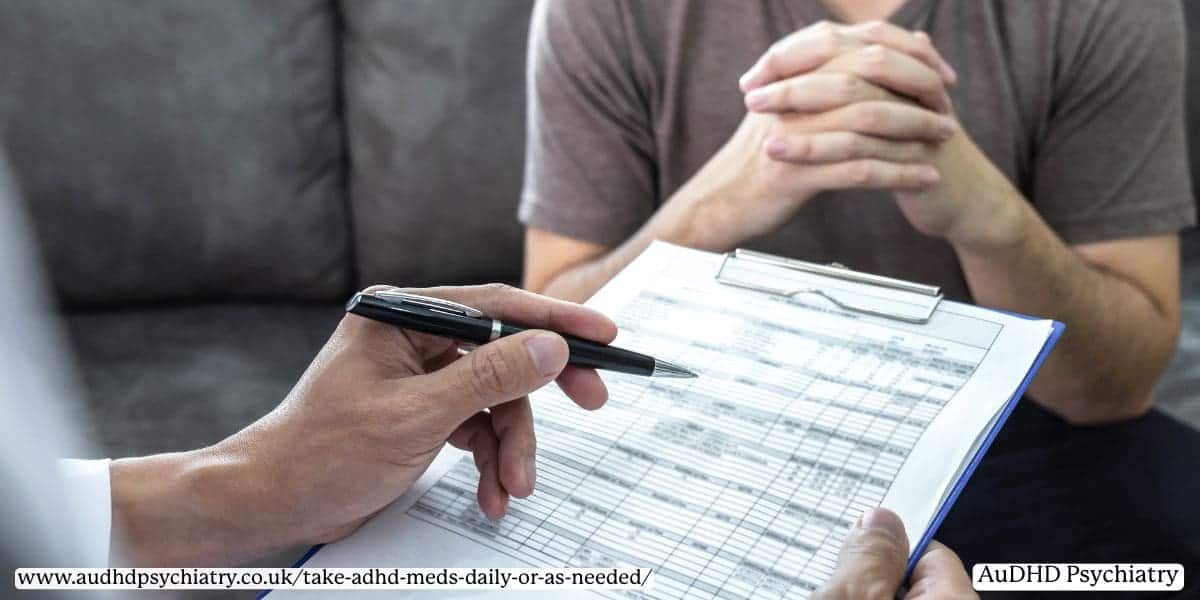
How to Track ADHD Medication Effectiveness
Whether your ADHD medication is taken daily or on an as-needed basis, knowing how well it’s working is key to optimising effective treatments. Tracking effectiveness helps identify when the benefits peak, when symptoms return, and whether side effects interfere with your routine.
What to Measure Beyond Focus
Don’t limit your tracking to concentration alone. Consider how medication affects:
- Emotional regulation
- Sleep and appetite
- Task initiation and completion
- Social and workplace interactions
Even subtle improvements like getting ready more quickly in the morning or handling unexpected changes with less stress are worth noting. Journals, symptom trackers, and digital ADHD apps can help spot trends that may otherwise go unnoticed.
When to Track Timing and Dosing
If you’re using ADHD medication as needed, it’s especially important to record when you took it and how long its effects lasted. This helps identify your ideal dosage window and ensures you’re not mistiming doses (which can lead to underperformance or side effects).
Tracking is especially important for those with coexisting health conditions such as heart disease or a history of substance use disorder, where medication effects can vary significantly. Understanding how your medication behaves over time also helps with discussions around formulation. In fact, choosing the best time of day to take your ADHD medication can make a significant difference in how consistently you function across your day.
This depends on whether you’re using a short-acting or extended-release option. For example, if a short-acting medication causes crashes midday, your prescriber may recommend trying an extended-release option. You can learn more about this in our comparison of Adderall, Ritalin, and Vyvanse, which explains differences in duration, effectiveness, and use cases.
Tracking is the best way to help you and your healthcare provider make data-driven changes and decide if you need to adjust the dose, switch medications, or practice daily or as-needed use.
Can You Switch Between Daily and As-Needed ADHD Medication Use?
Switching between a daily and as-needed ADHD medication schedule might seem like a flexible solution. For some individuals, it truly is. But these changes aren’t simply a matter of skipping or taking a pill on instinct. Altering your dosing routine can impact symptom control, side effects, and overall effectiveness, and should always be managed with the support of your healthcare provider.
When Might a Schedule Change Be Considered?
Common reasons to consider switching schedules include:
- Lifestyle changes, such as new work demands or school holidays
- Difficulty tolerating medication side effects on low-demand days
- Inconsistent symptom control with your current approach
A child may benefit from consistent dosing during the term, then take breaks during holidays. Conversely, an adult managing executive dysfunction might begin with PRN use, only to realise that daily medication provides more stable results. These shifts often require adjustments in dose strength, formulation, or even switching to a non-stimulant medication.
How to Make Changes Safely
Suddenly stopping or restarting stimulant medication can result in withdrawal symptoms, such as fatigue, low mood, or increased impulsivity. It may also lead to rebound effects, like temporary symptom intensification once the medication wears off.
If you’re considering a switch, consult your prescriber to create a clear plan that includes tracking, safety checks, and regular reviews. Our full guide on how to pause or stop ADHD medication explains how to taper safely and what signs to watch for. With clinical oversight and structured monitoring, adjusting your medication schedule can be both safe and effective, but should never be attempted without professional guidance.
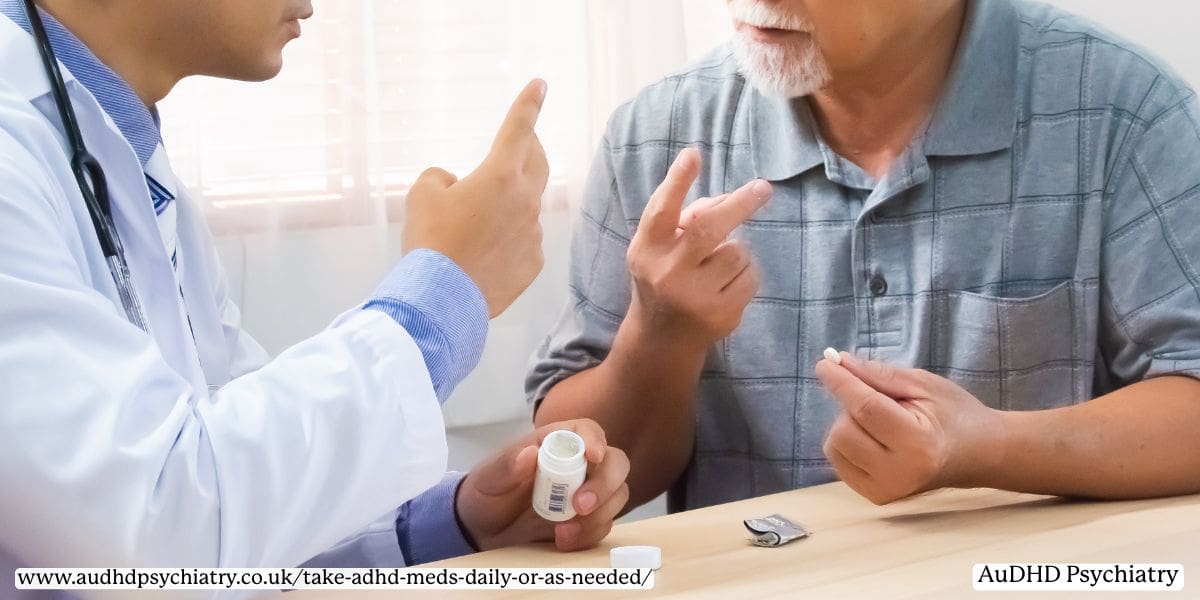
Medication Timing and Symptom Coverage
The time you take your ADHD medication can affect everything from symptom control to how well you sleep at night. Whether you’re following a daily or PRN schedule, dose timing plays a critical role in treatment effectiveness.
How Timing Influences Symptom Coverage
Stimulant medications are designed to support attention and self-regulation by altering levels of certain brain chemicals, particularly dopamine and norepinephrine. However, the duration of effect depends heavily on when you take your dose. Morning doses may wear off before evening responsibilities begin, while afternoon doses could interfere with sleep.
If you find that symptoms worsen later in the day, it might indicate a need for a second dose or switching to an extended-release stimulant. Individuals taking medication as needed should pay close attention to when symptoms occur and how long relief lasts.
Aligning Medication With Your Daily Routine
Aligning your dosage window with your personal schedule helps ensure the medication supports your most demanding moments. For those experiencing symptom gaps, late-afternoon fatigue, or rebound irritability, adjusting timing may be more helpful than increasing dosage. Our guide on the best time of day to take ADHD meds explores how morning vs. afternoon use affects focus, energy, and sleep.
Ultimately, medication should fit around your life, not disrupt it. With a personalised schedule and follow-up visits to your healthcare provider, you can manage side effects, reduce sleep problems, and improve daily performance.
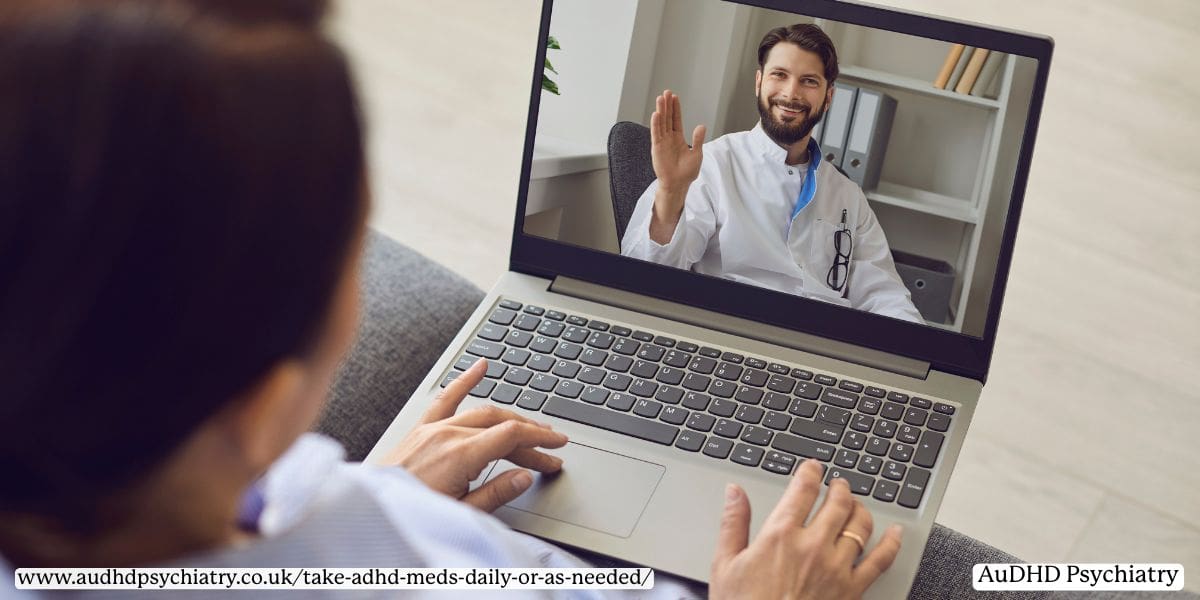
When to Talk to Your Doctor
No ADHD medication plan is meant to stay the same forever. Your treatment needs may shift as your schedule, stress levels, or symptoms evolve. Knowing when to contact your doctor ensures you get the most out of your medication while avoiding complications. If you’re ready to begin this process, you can book a screening call with our specialists. This first step ensures you receive a structured assessment and clear guidance before starting ADHD medication.
Signs Your Medication May Need Adjusting
Several indicators suggest it’s time to reassess your treatment:
- You notice more frequent or intense side effects
- Your symptoms are returning before your next dose
- You’re experiencing mood swings, loss of appetite, or sleep problems
- You suspect you need a dosage adjustment (too high or too low)
Physical signs like irregular heartbeat, high blood pressure, or chest discomfort should be treated as urgent. These may indicate that your current stimulant medication isn’t the right fit or needs adjustment.
Life Transitions That Call for Reassessment
Beyond side effects, major life events can change your treatment needs:
- Starting a new job or academic term
- Moving from adolescence to adulthood
- Managing coexisting conditions such as anxiety, Tourette syndrome, or bipolar disorder
Regular follow-ups help fine-tune your treatment plan and ensure you’re still on the lowest effective dose. These visits also allow your doctor to monitor any long-term risks associated with prescription medications, especially Schedule II stimulants. If you have already been evaluated and are now considering treatment, you can start ADHD medication after assessment with professional guidance to ensure safe and effective management.
Conclusion: Choosing the Right ADHD Medication Schedule
There is no one-size-fits-all answer to the question: “Should you take ADHD medication daily or as needed?” The most effective strategy is the one that aligns with your symptoms, lifestyle, and long-term goals, all while minimising risk.
Daily use may offer more consistent symptom control, particularly for individuals with severe ADHD or coexisting behavioural challenges. But daily exposure to medication also raises the risk of long-term side effects, including appetite suppression, emotional flatness, and sleep disruption.
PRN use, on the other hand, provides flexibility. It may be suitable for young adults, those with mild symptoms, or anyone experiencing medication fatigue. But it also demands careful tracking to avoid treatment gaps or inconsistent results. The key is to monitor how medication use, or non-use, affects your academic performance, executive function, and emotional regulation.
If you’re unsure which path is right for you, don’t guess. Partnering with an experienced provider can help you build a tailored plan that evolves with your needs. We can help you explore non-stimulant ADHD medications, assess individualised response, and manage possible side effects more effectively. Book a Private ADHD Assessment today and find support in creating the best treatment plan for you.
You Might Also Like
Contact Us
We’re here to answer any questions you might have.
Get in Touch
Opening Hours
Contact Form
We’re here to help. Reach out and we’ll get back to you within 24 hours (Monday – Friday).

